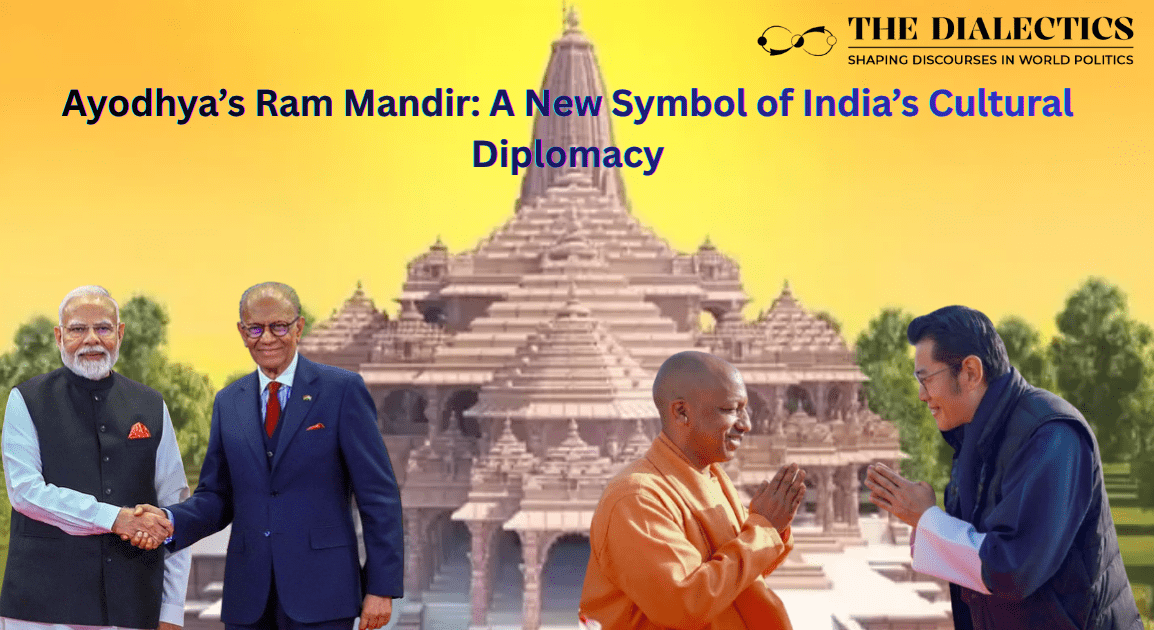The Ram Mandir in Ayodhya, inaugurated in January 2024, has become a cultural and diplomatic symbol of India. Within one and a half years of its consecration, the temple has drawn not only millions of devotees from across the country but also global attention. Heads of state, senior diplomats, and cultural representatives from around the world have visited Ayodhya to pay their obeisance. This highlights that there is a shift in India’s diplomatic engagement, where cultural heritage and civilisational values are used as tools in order to enhance Indian soft power.
From 9 to 16 September 2025, the Prime Minister of Mauritius, H.E. Dr. Navinchandra Ramgoolam, is on a state visit to India. As part of his cultural Schedule, he is scheduled to visit Varanasi, Ayodhya, and Tirupati. On September 12, he will offer prayers at the Ram Temple.
Similarly, Bhutan’s Prime Minister Dasho Tshering Tobgay visited India on an official tour last week. Along with official meetings, he and his wife visited Ayodhya and offered prayers at the Ram Temple and other important shrines.
These visits show how Ayodhya has become a central attraction for visiting dignitaries. It signifies not only its spiritual importance but also its growing diplomatic role.
A Historic Moment of International Attention
The consecration ceremony of the Ram Temple in January 2024 itself set the tone for this transformation. The temple trust invited over 100 dignitaries from more than 54 countries. It included ambassadors, parliamentarians, and even royal family representatives. Among the prominent guests were Kim Chil-su, tracing lineage to South Korea’s Queen Heo, as well as representatives from the USA, Britain, Australia, Africa, and Mauritius. That event displayed how Ayodhya is being projected as a global cultural destination and not merely a domestic religious site.
The pace at which the Ram Mandir has gained global recognition underlines its status as a symbol of Indian civilisational identity. Within a year, international recognition has increased, and the temple now contributes heavily to India’s cultural diplomacy and tourism sector.
From Mughal Monuments to Civilizational Heritage
Indian diplomacy historically relied on showcasing Mughal infrastructure such as the Taj Mahal or Qutb Minar during visits of foreign dignitaries. Lavish banquets and tours of such monuments often dominated the cultural aspect of state visits. Yet, these monuments, while architecturally beautiful, did not portray the core values and spiritual values of Indian civilisation.
The current government has consciously shifted away from this approach. For example, when PM Modi hosted Chinese President Xi Jinping in Mahabalipuram, an ancient Tamil coastal town rich in cultural and civilisational heritage. That marked a turning point where India began to highlight its Indic identity rather than Mughal legacies as the cultural backdrop of diplomacy. The Ram Mandir now strengthens this shift. It reflects India’s civilisational depth and spiritual continuity, which resonate with many of its neighbours in South and Southeast Asia.
Cultural Diplomacy in the 21st Century
In the second decade of the 21st century, as conflicts around the globe intensify, the role of cultural diplomacy has become important. Military alliances and economic negotiations are essential, but culture provides the emotional, civilisational, and people-to-people bridge between nations. Temples, monuments, language, food traditions, and shared legends all bind societies together beyond the realm of politics.
The Ram Mandir represents this potential for India. It is more than a religious site. It is a space that can foster shared cultural connections with India’s neighbours, such as Nepal, Bhutan, Sri Lanka, and the Southeast Asian nations, where the Ramayana tradition is deeply embedded. This symbolism increases the effectiveness of India’s Neighbourhood First and Act East policies, where cultural affinity becomes a natural binding force.
Similarly, India holds immense Buddhist heritage, including ancient shrines that are of great importance to countries like Thailand, Japan, Myanmar, and Sri Lanka. Just as Buddhist sites have historically connected India with these countries, the Ram Mandir can today serve as a new focal point of spiritual diplomacy rooted in Hindu tradition.
Ram Mandir: A Symbol of India’s Civilizational State
India is not merely a modern nation-state but a civilisational state with a legacy stretching thousands of years. The Ram Temple represents that living continuity. Its value is not limited to pilgrims or tourists, but extends to statesmanship and diplomacy. Each visiting dignitary who bows before Ram Lalla is, in a sense, acknowledging India’s cultural heritage and its role in shaping shared civilisational bonds.
This new approach also signals the rebalancing of India’s diplomatic image. Leaders from across the world may, in the future, prefer a visit to Ayodhya’s Ram Mandir rather than limiting themselves to the Taj Mahal. This shift underlines that India is no longer confined to projecting Mughal-era monuments but is once again embracing its true cultural identity.
The Ram Mandir’s importance transcends religion or tourism. It is fast becoming a diplomatic symbol, one that underscores India’s cultural diplomacy, strengthens people-to-people exchanges, and reflects the nation’s civilisational spirit. In the years ahead, Ayodhya has the potential to emerge as a true cultural capital where politics and culture complement each other in shaping global perceptions of India. By aligning its foreign policy with its civilisational heritage, India is reclaiming its cultural narrative and using it as a bridge to connect with the world.




